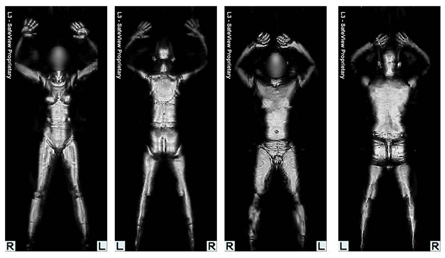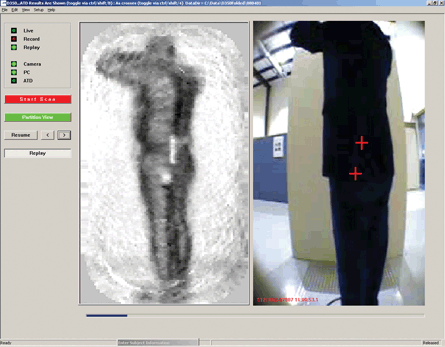The latest airline terrorist scare has led to a surge in demand for millimetre wave scanning technology, as interest from Canada, the UK and the Netherlands' Amsterdam Schiphol airport - where the would-be bomber boarded Northwest Airlines Flight 253 - joins a $165 million order from the USA for these devices that can detect foreign objects through clothing.
The technology has been around for several years and demand has been growing since the attacks of 11 September 2001. But how does it work? Different millimeter wave (MMW) platforms allow for discreet and distant scanning. The type ordered most resembles a large phone booth. Inside are two banks of transmitters and receivers, rotating around the scanned subject to send and receive waves as they bounce off skin and objects.
 |
|---|
© L-3 ProVisionThe TSA has given rare approval to the Backscatter X-Ray technology with an order for 150 units |
With detailed contours of the body recreated at every angle on a monitor, contraband is revealed by shape, texture and shading. When Pacific Northwest National Laboratory began development in 1989, rendering the image that resembles a film negative took 20min, says engineer Doug McMakin. "Today with the high-speed computers we have the imaging can be done in less than a second. It's amazing. When 9/11 hit, the world changed. It definitely changed for this technology," he says. McMakin says military applications, including at Green Zone checkpoints in Baghdad, pushed prices down and led to refinements.
Waves do not penetrate skin, so metal detectors continue to have a role to play in security checks. A Pacific Northwest National Laboratory report supported by the US Federal Aviation Administration noted other limitations: "The system cannot identify the chemical composition of the material, therefore the operator will not be able to determine specifically that an object is an explosive.
"The information that is presented is simply an image of the object. The operator must rely on this information to distinguish if this object is suspicious and should be removed for further examination."
The scanners are larger than metal detectors and take more time to use. Scan duration of 10s per person could slow the screening process. Manufacturers say they scan upwards of 400 passengers an hour.
Testing results of the US Transportation Security Administration will not be released for security reasons, it says, adding: "It is a proven technology and we are highly confident in its detection capability."
Forty ProVision scanners from L-3 Security & Detection are used in 19 US airports, with six machines in operation for primary screening at six airports and 34 machines used for secondary or random screening. When stationed as primary scanners and as an alternative to physical patdowns, the TSA says 98% of passengers choose the new machine.
NO COMPLAINTS
Airport officials in Denver and San Francisco say they have received no passenger complaints about the new machines. When Kelowna International airport in British Columbia, Canada's tenth largest airport, was the sole Canadian test site from June 2008 to January, 2009, a private consultant surveyed passenger satisfaction and monitored speed. The airport says: "We were just the host facility. We are just as curious as everyone else in the industry is as to what the findings would be."
The results emerged on 5 January from Canada's transport minister John Baird and Rob Merrifield, minister of state (transport), when they announced that scanners will be installed in major Canadian airports from this month.
On 30 December the TSA issued a $165 million contract for more of the L-3 ProVision scanners, which received TSA approval for airport checkpoints in December. More than 200 units are deployed worldwide. "Schiphol airport is also conducting a trial with 15 systems deployed at several checkpoints," says the airport.
 |
|---|
© Millivision TechnologiesMillivision Technologies uses passive MMW with an added automatic threat detection tool that identifies questionable objects
|
TSA approval is coveted and rare. ProVision is the only MMW scanner to earn it, as has the Backscatter X-Ray technology behind the Secure 1000 Single Pose of Rapiscan Systems. On 2 October the TSA ordered 150 units as part of a $173 million indefinite delivery, indefinite quantity contract that expires in 2014. Rapiscan has an MMW scanner as well, but emphasises its Backscatter units.
Rapiscan and L-3 began 20 months of TSA testing in 2007 as competitors watched them work toward the "qualified vendor list" with envy. The "eqo" MMW scanner by Smiths Detection touts screen resolution "down to 4 x 4mm (0.16 x 0.16in), but performance has yet to pass rigid TSA testing.
The same is true for Brijot Imaging Systems of Orlando and its GEN 2. By using passive MMW, the GEN 2 "does not radiate subjects, illuminate or emit any energy that could pose health risks to subjects or screener". (Active MMW scanners, such as L-3's ProVision, is said to emit energy equal to 1/10,000 of a mobile phone.) The passive waves also flexibility in the scanning zone, allowing hallways or doorways to discreetly scan passers-by.
Millivision Technologies also uses passive MMW, and president Paul Nicholas is eager for design goals to be spelled out so smaller companies can catch up. His aim is "to accelerate the process" and get the companies to "work more closely with us to provide grants and funding that will get this better technology and these better systems into the market. There hasn't been any guidance or direction for any of the vendors in the marketplace as far as what they deem acceptable. No-one wants to make that committment yet."
Millivision's 11 employees are conducting tests with the UK Home Office and the US Transportation Security Laboratory. Most MMW scanners blur the face of the subject, but Millivision goes further to use an "automatic threat detection tool" that identifies questionable objects and superimposes their shape on to a clothed photo of the subject.
Privacy concerns nearly derailed US interest in MMW and Backscatter in June, when the US House of Representatives voted 310-118 to ban whole body imaging at airports. Calling the technology "digital strip search devices," the Electronic Privacy Information Center filed a lawsuit against the US Department of Justice to force release of performance studies and specifications. Although such concerns are echoed during implementation, the TSA counters that agents viewing the monitor are secluded away from the scanners and never personally see the passenger being scanned.
TSA's testing includes the SPO-7R from Qinetiq North America. That directional unit is designed for mobility and mounts on a tripod. It found military use as a detector of Improvised Explosive Devices. The company says: "SPO-7R provides a simple green-yellow-red threat level indication, along with a standard video image of the subject."
Source: Flight International
















